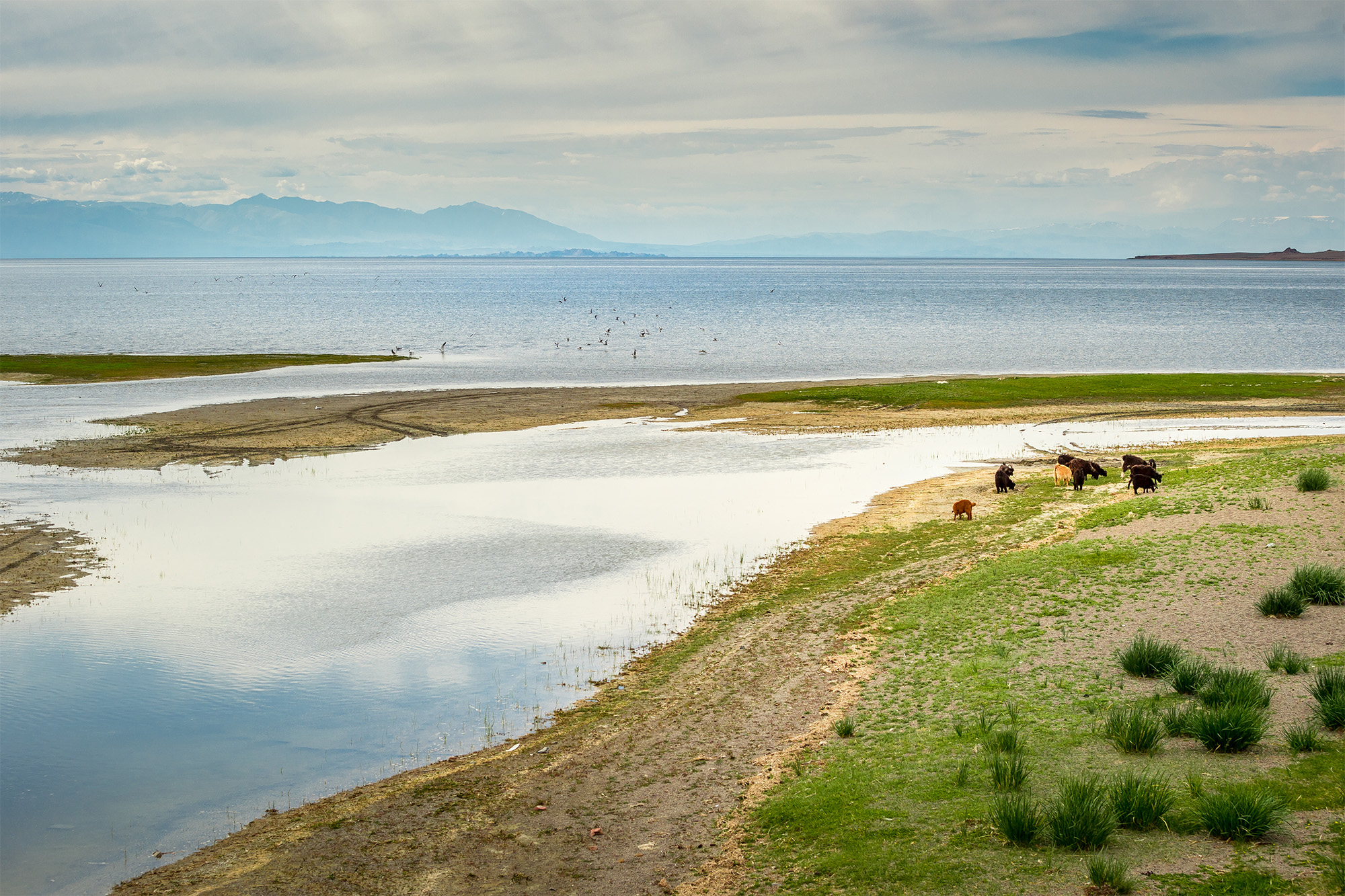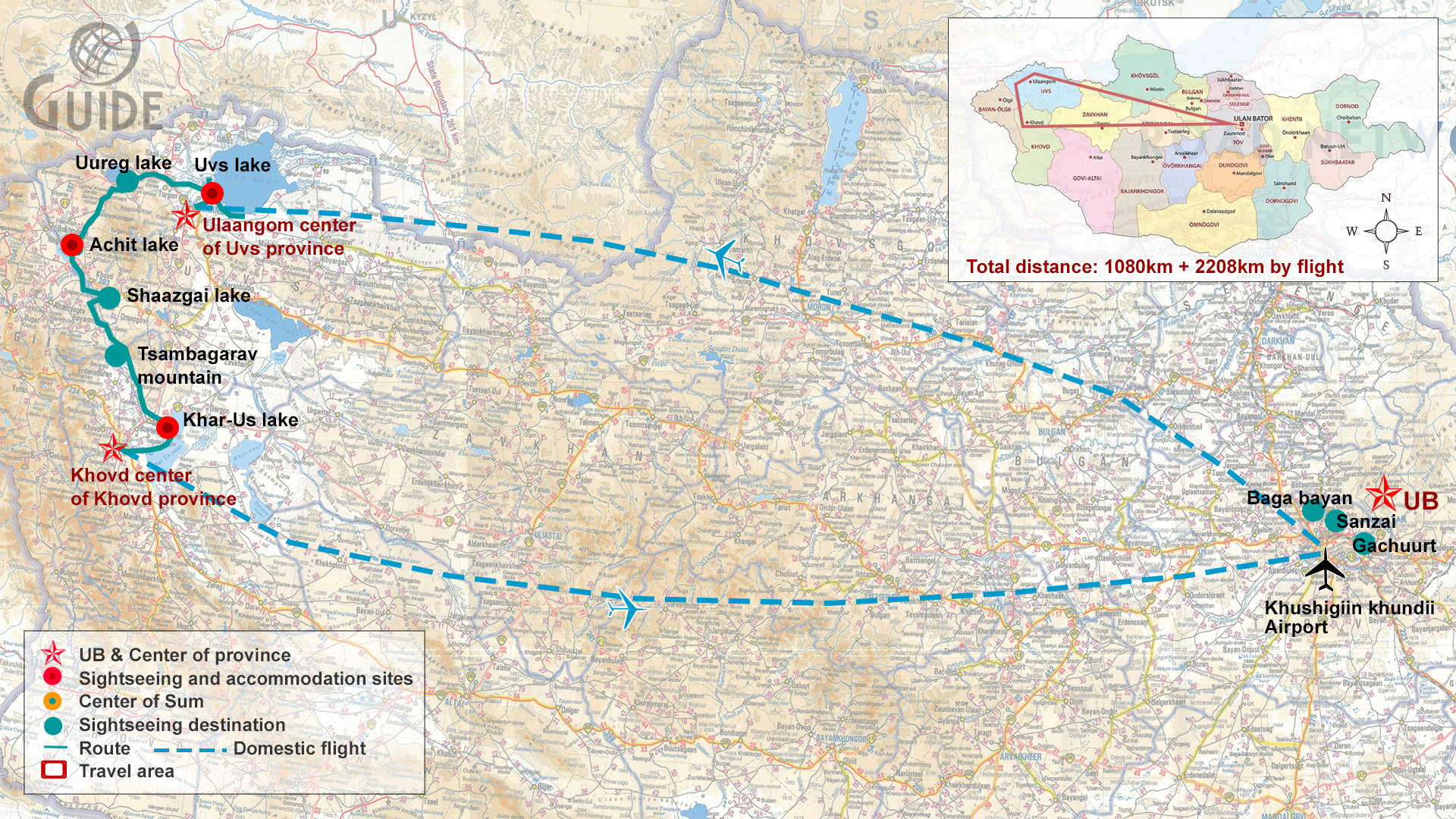Itinerary
DAY 1: Around UB (110 km)
Following the observation in the morning, we drive back to Ulaanbaatar after lunch. You will visit the Chinggis Khaan museum and stop by souvenir shops and cashmere boutiques. And arrive at the hotel to prepare for your back travel.
Meal: Breakfast, Lunch, Dinner
Accommodation: Hotel
DAY 1: Chinggis Khaan Airport – UB (60 km)
We welcome you to Mongolia at Chinggis Khaan Airport and our team will transfer you to a hotel. (International flights usually arrive early morning or late afternoon. If you arrive by morning flight, you will be offered to take a short spotting tour around city).
Meal: Dinner
Accommodation: Hotel
DAY 2: Ulaangom city – Uvs Lake 50 km
You will leave the hotel very early morning and depart by domestic flight to Ulaangom, provincial capital of Uvs. The flight takes about 3 and half hours. In Ulaangom, we get to know about the city while observing in the vicinity. After taking lunch there, we and head to the Mongolian largest lake, Uvs Lake. The region of Uvs lake provides the northern border of the Gobi desert distribution in Central Asia. The places located in the region such as Uvs Lake, Turgenii Mountains, Tsagaan Shuvuut (White birded mountains), Tes River Foothills, and Golden Sands are ecologically different, but not far from each other. In 1993, the entire depression of Uvs Lake was preserved as the state strictly protected area and UNESCO registered it among 200 important ecoregions.
Meal: Breakfast, Lunch, Dinner
Accommodation: Tourist camp
DAY 3: Uvs Lake (80 km)
On this day, we will spot along the shore and observe the lake environment. Uvs Lake is the largest in Mongolia with its length of 84 km and width of 79 km. The depth is 12-15 meters and covers area of 3350 sq km. It is an endorheic lake without outflow, and its water is considered five times saltier than sea water. There are 38 rivers flowing into the lake and it is a habitat of numerous species of fish. Plants such as reeds, sedges, bushes, shrubs, willows, and poplars grow on its shores. More than 200 species of birds have been recorded in the region, and among of them can be found very rare wetland birds such as Eurasian Spoonbill, Great Egret, White-headed Duck, Great Black-headed Gull, Horned Grebe, White-tailed Eagle.
Meal: Breakfast, Lunch, Dinner
Accommodation: Tourist camp
DAY 4: Uureg Lake – Achit Lake (200 km)
You will make an observation around the area of Uureg and Achit lakes. Located in the foothills of the ever-snow-capped mountains, the scenery of these lakes is spectacular and numerous water birds come to roost throughout summer. Uureg Lake is an endorheic lake which is located in a closed depression between Tsagaan Shuvuut and Turgenii mountains. The entire shoreline of the lake is slightly sloping, and the lake hasn’t any bays, river-bends, or peninsulas. A few rivers fed by rainwater flow into it. Its variety of shrubs and willows growing in the wetland area makes it a safe habitat for water birds. Uureg lake is also an endorheic and saline lake. Its deepest part reaches to depth of 42 meters. On the other hand, Achit Lake is a lake fed by the water of several rivers that flow sourced from the snow and glaciers of the major branches of the Mongolian Altai Mountain ridges. The lake has an area of 311 square kilometers, is 30 kilometers long, 16 kilometers wide, and has an average depth of 5 meters.
Meal: Breakfast, Lunch, Dinner
Accommodation: Tourist camp
DAY 5: Shaazgai Lake (Magpie Lake) - Tsambagarav Mountain (200 кm)
Early morning, we head to Tsambagarav mountain for spotting. Shaazgai Lake is a small salt-marsh lake that covers an area of 4.7 square kilometers and is located between two mountains. "Shaazgai" is the name of the magpie bird. According to a legend, this lake once had fresh water and there were no chirping magpies around it. The locals called the lake "Magpie" because they wished "numerous magpies would come and tell the news of the neighborhood." With the passage of time, the fresh water turned into salt marsh water, and people from far and neighborhood areas came to take salt. And, it is said that the locals interpret the magpies’ songs as the people would come for taking salt. In ancient Mongolian legends, intelligent birds magpies are said to be the birds "carrying gossip", and if a magpie is chirping, it means that visitors will come. Mount Tsambagarav is a branch of the Mongolian Altai mountain range, located in Khovd province, 4195 meters high above sea level, and snow-capped mountain. Take field lunch and observe all day long. In the evening, we return to Khovd city and rest in the hotel.
Meal: Breakfast, Lunch, Dinner
Accommodation: Hotel
DAY 6: Khar Us Lake (Black Watered Lake) – Khovd city (80 km)
We drive to Khar Us Lake early in the morning. One of the largest lakes in Mongolia, Khar Us Lake has an area of 1153 square kilometers, 72 km long and 26 km wide. It has an island in the middle, and bamboo trees and reeds grow on its southern edge. It is a very shallow fresh watered lake inhabited by wild boar. The deepest part reaches 4.4 meters and the average depth is 2 meters. Among the 10 big and small islands of Khar Us Lake, the largest one is Agshab Island, which is about 30 km long and 272 meters above the water level. This island divides the lake into large and small parts: north and south. After observing this site, we arrive at the capital of Khovd province and stay at a hotel. Khovd province is a land of a various ethnic groups, where you will get to know more about the way of life of the people of Western Mongolia and you will spend an evening listening to music.
Meal: Breakfast, Lunch, Dinner
Accommodation: Hotel
DAY 7: UB ( 1104 km by domestic flight)
Return to Ulaanbaatar by domestic flight. We spot the birds along the banks of the Tuul River, and the bridge of Marshal. Tuul river flows through the southern edge of the city and is the main freshwater source for UB. The river originates from the Khentii mountain region and flows to the west by the southern edge of the UB city and streams to Selenge River, the largest river in Mongolia which drains into Lake Baikal. Next, we will observe the Songinin am and Nukhtiin am which are the northern pass of Bogd Khan Mountain. There we stay in a hotel nearby.
Meal: Breakfast, Lunch, Dinner
Accommodation: Hotel
DAY 8: Baga Bayan – Sanzai – Gachuurt – Terelj (150 km)
After early breakfast, you will sport in the forest area around Baga Bayan and Sanzai, which is a summer camp area on the northern outskirts of UB city. Interesting species of small forest birds can be seen in these places. From there, we move to the east to observe near the Gachuurt village and lodge at a tourist camp in the Terelj area. Terelj is a beautiful natural area of 2268 square kilometers near the city of UB. The regional landscape is assembled with rocky mountains and dense forests. It is a specially protected area that is visited by a large number of tourists, and you will see natural features along the way. But the bird-watching points will be the quietest, most beautiful, and least crowded place in the area. If you wish, you can leisurely ride a horse there.
Meal: Breakfast, Lunch, Dinner
Accommodation: Tourist camp
DAY 10: Chinggis Khaan Airport (55 km)
Our team transfers you to the airport according to your departure time from Chinggis Khaan Airport.
Meal: Breakfast






